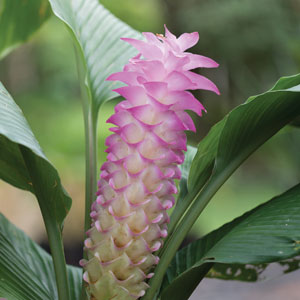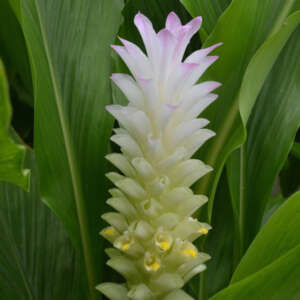Curcuma Growing Guide

What is Curcuma?
Curcuma (Curcuma spp.) also known as Turmeric is a herbaceous perennial. Part of the Zingiberaceae or ginger family, it is native to Southern Asia and India. There are about 100 different species of Curcuma where some can be used for foods and dyes while other species are used as ornament plants in gardens. Usually the plants have long stalked broad leaves that emerge from rhizomes from Spring until Autumn where they go into dormancy over the Winter. Most have large showy flower spikes that come in a variety of colours ranging from pinks, whites, oranges and yellows. Their bracts also come in different colours. Flowering times usually start late Spring early Summer. Depending on the variety will depend on what shows first, the foliage or the flowers. Check your varieties before planting as some varieties like full sun while others like shade but they all need moist well draining soil. Some varieties will need protection from wind and direct sun.
Some species are ornamental such as Curcuma petiolata where others can be harvested and eaten such as Curcuma longa. If you have chosen an edible variety then, when it starts to look a little sad in late Autumn or early Winter, it’s a good time to lift the plant and harvest the rhizomes. They can usually be harvested 9 to 10 months after planting. The lower leaves will either start turning yellow or the stems will start to dry and fall over are good indications of maturity. It is possible for the home gardener to just dig carefully at the side of a clump and remove rhizomes as needed rather than harvesting the whole clump.
Benefits of Growing Curcuma
Curcuma are easy to grow and bring that tropical look to cooler region gardens. They are an ideal plant for wooded gardens, tropical style gardens or, smaller varieties, planted in pots. Their large showy flowers will stand out in the garden and can also be used as a cut flower. If you have chosen an edible plant then the dried rhizome of the Curcuma plant is ground up to use as the culinary Turmeric, and the flowers and young leaves of this plant can be used as a vegetable. In Indonesia, the young shoots and rhizome tips are eaten raw while the leaves are used to wrap around fish to add flavour during cooking.
How to Grow Curcuma
Climatic Zones
Temperate to tropical.
Plant Size
Sizes vary.
When To Plant Curcuma
Plant in Spring.
Soil Preparation
Curcuma like a moist, compost-rich well-drained soil that has a good layer of mulch. Prior to planting work well broken down animal manure, blood and bone or complete fertiliser through the soil.
How To Plant Curcuma
Check the variety as to whether it needs full sun or shade. Plant your rhizome around 5-10cm underneath the soil surface, 15-30cm apart.
Curcuma Plant Care
Requires consistently moist soil, do not let dry out between waterings. Water when natural rainfall isn’t sufficient. Keep dry when dormant.
Regularly mulch to keep moisture in the soil and keep the rhizomes cool.
Rhizomes left in the ground during wet Winters may rot, so they are best lifted and stored in a warm, dry place, then planted out again in Spring.
Cut back watering during Winter months. Remove any spent flowers or dead foliage during the growing period. Cut the yellow leaves off during harvesting.








